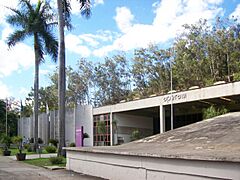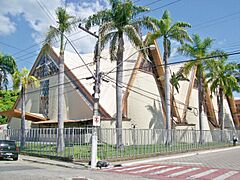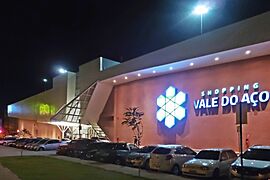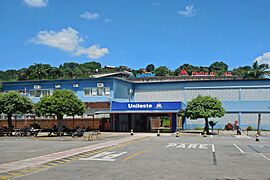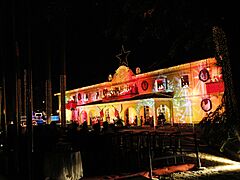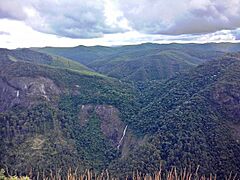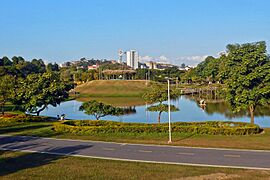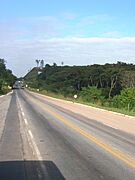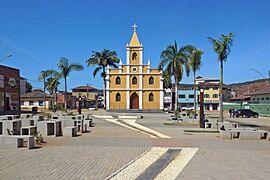Vale do Aço metropolitan area facts for kids
Quick facts for kids
Vale do Aço Metropolitan Area
|
|
|---|---|
|
Metropolitan Area of Brazil
|
|
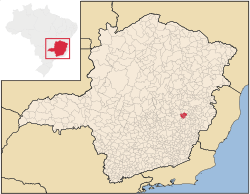 |
|
| Country | |
| Region | Southeast |
| State | |
| Area | |
| • Total | 807.246 km2 (311.679 sq mi) |
| Elevation | 852.19 m (2,796 ft) |
| Population | |
| • Total | 451,351 |
| • Density | 7,290.8/km2 (17,521/sq mi) |
| Time zone | UTC-3 (BST) |
| • Summer (DST) | UTC-2 (BDT) |
| Postal Code |
30000-000
|
| Area code(s) | +55 31 |
The Vale do Aço Metropolitan Area is a group of cities in Minas Gerais, Brazil. Its name means "Steel Valley" in Portuguese. This area includes four main cities: Coronel Fabriciano, Ipatinga, Santana do Paraíso, and Timóteo. It also influences 22 other nearby towns.
Contents
History of the Steel Valley
The Vale do Aço region is also known as the "Ironcasting Region." This is because many companies that process iron and steel are located here. These companies are found along the Rio Doce and its smaller river, the Rio Piracicaba.
Building the Railway
The area started to become industrial in the 1920s. This happened after a big railway, the Estrada de Ferro Vitória Minas, was built. This railway connected the city of Vitória to Belo Horizonte. It passed through many forests that had not been touched much before.
Early Industries and Growth
Soon after the railway was finished, an iron company called Belgo-Mineira started working in Coronel Fabriciano. They bought wood from local forests to make charcoal. This charcoal was used as fuel for their factories.
In 1944, a company called Acesita (now Aperam South America) was built in what is now Timóteo. Acesita makes special types of steel, like stainless steel. In 1948, Coronel Fabriciano became its own municipality. This new area included what are now Timóteo and Ipatinga.
In 1956, another big steel company, Usiminas, was built in the Ipatinga area. Later, in 1964, Ipatinga and Timóteo became separate cities from Coronel Fabriciano.
In 1973, Cenibra, a company that makes pulp for paper, was built in Belo Oriente. This town is in the area influenced by Vale do Aço.
The Vale do Aço Metropolitan Area was officially recognized in 1998. In 2005, about 430,700 people lived there.
Cities in Vale do Aço
There isn't one official main city in the Vale do Aço Metropolitan Area. However, Ipatinga is the largest city by far. It has about 240,000 people.
The second largest city is Coronel Fabriciano, with about 105,000 people. Next is Timóteo, which has about 80,000 people.
Here is a table showing the main cities in the area:
| Municipality | Area (km²) | Population (2008) |
|---|---|---|
| Ipatinga | 166 | 241.720 |
| Coronel Fabriciano | 221 | 104.415 |
| Timóteo | 145 | 79.813 |
| Santana do Paraíso | 276 | 24.105 |
| Total | 808 | 449.340 |
Main Industries
The biggest industries in the Vale do Aço region are Aperam South America and Usiminas. Both of these companies work with iron and steel. Cenibra, a factory that makes pulp (which is used to make paper) in Belo Oriente, is also very large.
There are many other smaller businesses in the area. Some of them work closely with the big companies. They might supply materials to the big companies or buy their products.
Eucalyptus and Charcoal
The region has many eucalyptus trees planted in large farms. These trees were first used to make charcoal for the iron factories. Later, Usiminas and Acesita started using imported mineral charcoal. Now, the eucalyptus trees are mainly used to provide raw material for Cenibra's pulp factory.
Images for kids
-
Vale do Aço Regional Airport in Santana do Paraíso
-
Shopping Vale do Aço, a shopping mall in Ipatinga
See also
 In Spanish: Región metropolitana de Vale do Aço para niños
In Spanish: Región metropolitana de Vale do Aço para niños


